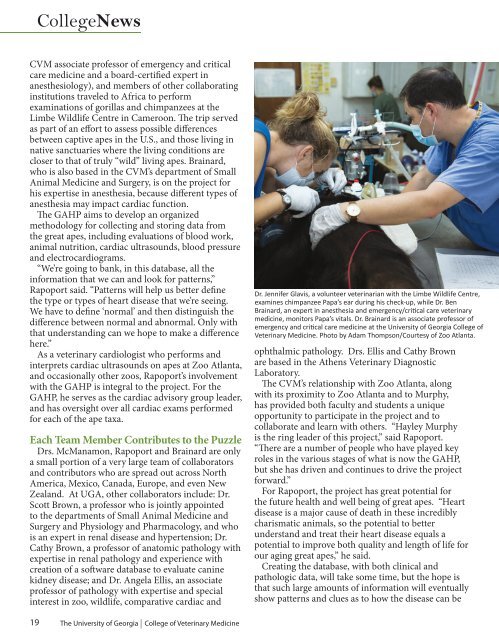Spring/Summer 2013 Aesculapian Magazine - University of Georgia ...
Spring/Summer 2013 Aesculapian Magazine - University of Georgia ...
Spring/Summer 2013 Aesculapian Magazine - University of Georgia ...
You also want an ePaper? Increase the reach of your titles
YUMPU automatically turns print PDFs into web optimized ePapers that Google loves.
CollegeNews<br />
CVM associate pr<strong>of</strong>essor <strong>of</strong> emergency and critical<br />
care medicine and a board-certified expert in<br />
anesthesiology), and members <strong>of</strong> other collaborating<br />
institutions traveled to Africa to perform<br />
examinations <strong>of</strong> gorillas and chimpanzees at the<br />
Limbe Wildlife Centre in Cameroon. The trip served<br />
as part <strong>of</strong> an effort to assess possible differences<br />
between captive apes in the U.S., and those living in<br />
native sanctuaries where the living conditions are<br />
closer to that <strong>of</strong> truly “wild” living apes. Brainard,<br />
who is also based in the CVM’s department <strong>of</strong> Small<br />
Animal Medicine and Surgery, is on the project for<br />
his expertise in anesthesia, because different types <strong>of</strong><br />
anesthesia may impact cardiac function.<br />
The GAHP aims to develop an organized<br />
methodology for collecting and storing data from<br />
the great apes, including evaluations <strong>of</strong> blood work,<br />
animal nutrition, cardiac ultrasounds, blood pressure<br />
and electrocardiograms.<br />
“We’re going to bank, in this database, all the<br />
information that we can and look for patterns,”<br />
Rapoport said. “Patterns will help us better define<br />
the type or types <strong>of</strong> heart disease that we’re seeing.<br />
We have to define ‘normal’ and then distinguish the<br />
difference between normal and abnormal. Only with<br />
that understanding can we hope to make a difference<br />
here.”<br />
As a veterinary cardiologist who performs and<br />
interprets cardiac ultrasounds on apes at Zoo Atlanta,<br />
and occasionally other zoos, Rapoport’s involvement<br />
with the GAHP is integral to the project. For the<br />
GAHP, he serves as the cardiac advisory group leader,<br />
and has oversight over all cardiac exams performed<br />
for each <strong>of</strong> the ape taxa.<br />
Each Team Member Contributes to the Puzzle<br />
Drs. McManamon, Rapoport and Brainard are only<br />
a small portion <strong>of</strong> a very large team <strong>of</strong> collaborators<br />
and contributors who are spread out across North<br />
America, Mexico, Canada, Europe, and even New<br />
Zealand. At UGA, other collaborators include: Dr.<br />
Scott Brown, a pr<strong>of</strong>essor who is jointly appointed<br />
to the departments <strong>of</strong> Small Animal Medicine and<br />
Surgery and Physiology and Pharmacology, and who<br />
is an expert in renal disease and hypertension; Dr.<br />
Cathy Brown, a pr<strong>of</strong>essor <strong>of</strong> anatomic pathology with<br />
expertise in renal pathology and experience with<br />
creation <strong>of</strong> a s<strong>of</strong>tware database to evaluate canine<br />
kidney disease; and Dr. Angela Ellis, an associate<br />
pr<strong>of</strong>essor <strong>of</strong> pathology with expertise and special<br />
interest in zoo, wildlife, comparative cardiac and<br />
Dr. Jennifer Glavis, a volunteer veterinarian with the Limbe Wildlife Centre,<br />
examines chimpanzee Papa’s ear during his check-up, while Dr. Ben<br />
Brainard, an expert in anesthesia and emergency/critical care veterinary<br />
medicine, monitors Papa’s vitals. Dr. Brainard is an associate pr<strong>of</strong>essor <strong>of</strong><br />
emergency and critical care medicine at the <strong>University</strong> <strong>of</strong> <strong>Georgia</strong> College <strong>of</strong><br />
Veterinary Medicine. Photo by Adam Thompson/Courtesy <strong>of</strong> Zoo Atlanta.<br />
ophthalmic pathology. Drs. Ellis and Cathy Brown<br />
are based in the Athens Veterinary Diagnostic<br />
Laboratory.<br />
The CVM’s relationship with Zoo Atlanta, along<br />
with its proximity to Zoo Atlanta and to Murphy,<br />
has provided both faculty and students a unique<br />
opportunity to participate in the project and to<br />
collaborate and learn with others. “Hayley Murphy<br />
is the ring leader <strong>of</strong> this project,” said Rapoport.<br />
“There are a number <strong>of</strong> people who have played key<br />
roles in the various stages <strong>of</strong> what is now the GAHP,<br />
but she has driven and continues to drive the project<br />
forward.”<br />
For Rapoport, the project has great potential for<br />
the future health and well being <strong>of</strong> great apes. “Heart<br />
disease is a major cause <strong>of</strong> death in these incredibly<br />
charismatic animals, so the potential to better<br />
understand and treat their heart disease equals a<br />
potential to improve both quality and length <strong>of</strong> life for<br />
our aging great apes,” he said.<br />
Creating the database, with both clinical and<br />
pathologic data, will take some time, but the hope is<br />
that such large amounts <strong>of</strong> information will eventually<br />
show patterns and clues as to how the disease can be<br />
19<br />
The <strong>University</strong> <strong>of</strong> <strong>Georgia</strong> College <strong>of</strong> Veterinary Medicine

















